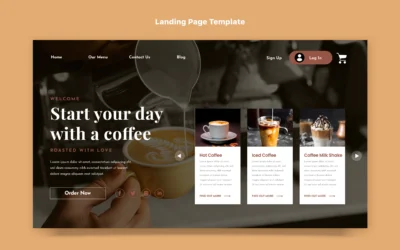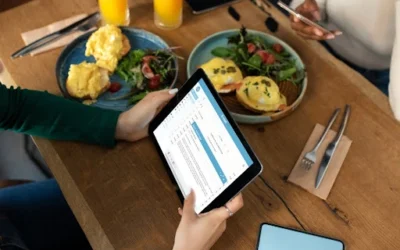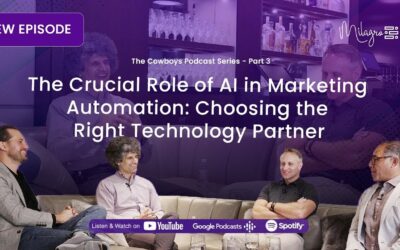4 Ways Technology is Transforming the Restaurant Experience
QR code ordering, virtual kitchens, and robot delivery services have transformed the restaurant industry in recent years. Businesses are leveraging technology to remain competitive, adapt to challenges, and meet evolving customer expectations. These innovations are not only keeping restaurants current but also driving further change in the industry.
Here are four ways technology is influencing the current and future of the restaurant industry.
- Making Restaurants More Accessible: A survey found that people in the U.S. order delivery about 4.5 times a month, and 57% prefer takeout or delivery over dining in. Technology is helping restaurants meet this demand by allowing customers to order food in various ways – whether they want to eat in, pick up an order, or have it delivered. With the right tech, restaurants can gather customer data, improve their loyalty programs, and offer rewards that match customers’ buying habits. This helps restaurants personalize their services and encourage repeat business.
- Improving the Dine-In Experience: Lately, restaurants have been focusing on creating unique experiences. This includes attractive interior designs, artistic food presentation, and immersive brand experiences. But technology is also becoming a big part of the dining experience. Self-ordering kiosks, QR menus, and delivery apps are becoming more popular. These digital ordering options are liked by dine-in customers as they can place their orders quickly and customize their meals. These technologies also benefit restaurants as they can suggest add-ons to increase order sizes and save on front-of-house costs.
- Supporting Employees: The restaurant industry often sees high staff turnover, with rates estimated at 75%. This can be due to low pay, stress, and long hours. While bigger changes may be needed, technology can make the workplace more appealing. For instance, a Point of Sale device that shows real-time menu information can help staff answer customer questions easily. This reduces stress and makes work more efficient. As more tech-savvy young people join the industry, using modern technology can make a restaurant more attractive to potential employees.
- Using Data for Business Improvement: By understanding your data and using cloud-based analytics, restaurants can make smarter decisions. For example, you can use data on food usage to improve efficiency and reduce waste. If you run a burger chain, a platform like Milagro can help you manage your inventory. Every time you make a cheeseburger, the system will automatically update your stock levels. This helps you track your usage and avoid over or understocking ingredients, saving costs. Clear data can also help you improve your service by understanding customer preferences and adjusting your offerings accordingly.
A TECHNOLOGICAL TRANSFORMATION OF DINING EXPERIENCES
The restaurant industry, a cornerstone of culinary culture, is experiencing a significant shift driven by rapid technological progress. Technology has become essential in various aspects of the dining experience, from restaurant discovery and selection to ordering, kitchen operations, and payment methods. Here we delve into how technology has revolutionized the restaurant industry, boosting efficiency, enhancing customer experiences, and influencing the future of dining.
- Finding Restaurants with Digital Menus: Nowadays, people use technology to find new restaurants. They can look at digital menus, reviews, and ratings online. Apps and websites help people find new places to eat. Sites like Yelp, TripAdvisor, and Google Reviews let customers share their experiences. Social media also helps show what a restaurant is like.
- Online Reservations Make Booking Easier: People no longer have to wait in line or call to book a table. Online reservation platforms let diners book a table easily. Services like SmartWAIT let users see available times, choose one, and confirm the booking. This makes the customer experience better and gives restaurants useful data.
- Digital Ordering and Delivery Bring Food to Your Door: Food delivery apps have changed the way we eat. Apps like Uber Eats, DoorDash, and Grubhub let people enjoy restaurant food at home. For restaurants, these platforms offer new ways to make money and reach more customers. They also help restaurants manage orders better and reduce mistakes.
- Tableside Technology Improves the Dining Experience: In the restaurant, diners can use technology to enhance their experience. Many places use tablets or digital kiosks to offer interactive menus. Customers can browse, customize, and order right from their table. This technology also helps communicate with the kitchen staff, reducing wait times and making sure orders are correct. Plus, it can provide extra information about the food, like nutrition facts, allergen info, and wine pairings.
- Kitchen Automation and Robotics: Technology has changed how kitchens work with automation and robotics. Automated kitchen appliances like smart ovens, grills, and fryers have advanced features for better control over cooking. This improves the quality of dishes and saves energy. Robots in kitchens are also becoming popular. They can do tasks like food prep, dishwashing, and bartending, which reduces labor costs and makes operations smoother.
- Augmented Reality (AR) and Virtual Reality (VR): AR and VR technologies are creating immersive dining experiences. Some restaurants use AR to enhance menus, letting diners see dishes in 3D before ordering. This makes the dining experience more interactive and helps with decision-making. VR takes this further by creating virtual environments that add to the dining experience. Diners can go on virtual journeys, like exploring the origins of a dish or visiting the places where ingredients come from.
- Contactless Payments: Traditional ways of paying with a credit card or cash are being replaced by contactless payment options. Mobile wallets, QR code payments, and NFC technology let diners pay using their smartphones. This is more convenient for customers and safer, especially considering health and safety concerns.
- Data Analytics: The data from digital interactions, reservations, and transactions gives restaurants valuable insights into customer preferences and behavior. Data analytics tools let restaurants personalize the dining experience with targeted promotions, loyalty rewards, and customized recommendations. For example, if a customer often orders vegetarian dishes, the restaurant can suggest new plant-based items. This personalized approach improves customer satisfaction and encourages repeat visits.
- Sustainability Tracking: As sustainability becomes more important to consumers, technology is being used to track and share a restaurant’s eco-friendly practices. Apps and websites can highlight sustainable sourcing, waste reduction efforts, and energy-efficient practices. This helps diners who care about the environment make informed choices. Restaurants can use technology to show their commitment to sustainability, attracting customers who prefer eco-friendly dining options.
The Future of the Order Food System
The future of the order food system is marked by several exciting trends that are expected to further revolutionize the restaurant industry.
- Integration with AI: Artificial Intelligence has evolved from a mere buzzword to a transformative reality. AI technology can enhance the order food system by understanding customer behaviors, preferences, and dietary requirements. This enables personalized meal suggestions and ensures more precise order processing.
- Use of Chatbots: Chatbots offer a seamless food ordering experience and real-time support to customers. They can swiftly address queries, help navigate the menu, provide detailed product information, and facilitate order placement.
- Voice Technology: With the increasing popularity of voice-activated devices like Amazon Alexa and Google Home, integrating the order food system with these platforms is a natural progression. This means that in the future, customers could order food simply by speaking to their smart device.
- Cloud Kitchens: Cloud kitchens, also known as virtual or dark kitchens, are food preparation facilities designed exclusively for meal delivery. The order food system aligns well with cloud kitchens, allowing food establishments to operate without a physical presence, leading to significant cost savings.
How AI is revolutionizing the restaurant industry
In today’s rapidly evolving technological landscape, the restaurant industry is poised to welcome innovation and transformation. Artificial intelligence (AI) has become a revolutionary tool that is changing the way restaurants operate. With its capacity to streamline operations, enhance customer experiences, and drive overall success, AI has become an indispensable asset for modern restaurants.
Understanding AI: Unleashing the Power of Technology
At its heart, AI involves developing computer systems that can perform tasks that have typically need human intelligence. By utilizing machine learning, natural language processing, and data analysis, AI empowers computers to process information, learn from it, and make intelligent decisions. Through AI algorithms, businesses can analyze extensive data, recognize patterns, and gain valuable insights to guide strategic decision-making.
Streamlining Operations with AI
Efficient operations are crucial to a restaurant’s success, and AI offers a variety of tools and applications to optimize processes and increase productivity. Predictive analytics, for instance, can help restaurants anticipate customer demand, allowing them to manage inventory levels effectively, reduce food waste, and lower costs. Additionally, AI-powered scheduling software can automate staff scheduling, considering factors such as peak hours and employee availability, leading to efficient labor management.
Elevating Customer Experiences with AI
One area where AI excels is in transforming the customer experience. Restaurants can utilize AI-powered chatbots to provide immediate, personalized assistance to customers. These virtual assistants can handle reservations, address common queries, and even suggest dishes based on customer preferences. Furthermore, voice assistants enabled by AI can simplify the ordering process, making it easier for customers to order using voice commands.
Leveraging Data Insights for Growth
Predictive Analytics
AI allows restaurants to use past data to forecast customer behavior, trends, and demand patterns, helping them make smart choices and improve their business strategies.
Menu Engineering
By analyzing customer feedback, sales data, and market trends, AI can help restaurants optimize menu offerings, identify popular dishes, and create new culinary experiences tailored to customer preferences.
Marketing and Promotion
The data-focused features of AI help restaurants create personalized marketing campaigns. By studying customer behavior and preferences, AI algorithms can create specific promotions, personalized offers, and loyalty rewards. AI-driven marketing systems can automate email campaigns, analyze customer feedback, and predict future customer behavior, allowing restaurants to develop stronger connections with their customers.
AI Adoptions in Restaurants
By adopting AI technology, restaurants can enhance their operations, enhance customer experiences, and promote growth. The examples provided highlight how AI is being utilized across different areas of the restaurant industry, demonstrating its transformative impact on the way restaurants operate and interact with their customers.
Drive-Thru AI
The implementation of AI in the drive-thru experience is transforming the way customers place their orders and enhancing overall efficiency. Companies such as Hi Auto and Valiant are leading the way in adopting AI technology in drive-thru systems.
AI assistants with natural language processing skills can effectively handle orders, manage payments, and guarantee precise order completion. Through AI utilization, restaurants can simplify the drive-thru process, cutting down on wait times and enhancing customer contentment. The AI assistants use sophisticated algorithms to examine customer choices, allowing them to offer personalized suggestions, leading to a more customized dining experience.
AI Phone Answering/Ordering Systems
Synq3 and Sound Hound are transforming phone interactions in restaurants by providing AI-driven phone answering and ordering systems. With over 10,000 restaurants, including popular chains like Chipotle, Panera, and Domino’s, utilizing these AI phone attendants, the industry is witnessing a significant transformation.
AI attendants can efficiently handle customer orders, answer queries, and provide seamless customer service, all while ensuring accuracy and timeliness. These AI systems use natural language processing and voice recognition technologies to comprehend customer requests and preferences, delivering a seamless and personalized ordering experience over the phone.
AI-Powered Social/Customer Review Systems
Restaurants are using AI to efficiently handle customer reviews and complaints, allowing them to quickly respond and address customer issues like Milagro. AI algorithms play a crucial role in analyzing and interpreting online feedback from various platforms, such as social media and review websites.
Through analyzing this data, AI systems can pinpoint trends, sentiments, and common customer concerns. Restaurants can use these findings to enhance their offerings, service standards, and overall customer experience. AI-driven social/customer review systems also aid restaurants in addressing reviews promptly and personally, boosting customer satisfaction and loyalty.
AI is changing the restaurant sector by providing creative solutions to improve customer experiences, streamline operations, and boost growth. We acknowledge the significant potential of AI in transforming restaurants and continue to lead in utilizing this technology to empower businesses.
By embracing AI, restaurants can offer personalized experiences, simplify operations, optimize menus, and guarantee food safety. As the industry progresses, AI will become more crucial in assisting restaurants to tackle challenges and capitalize on opportunities in the future.
How technology has improved restaurant operations
The restaurant industry has seen a rise in various technologies and companies offering solutions for both back-of-house (BOH) and front-of-house (FOH) operations. These technologies serve different purposes and help restaurants achieve various objectives. Three primary ways in which technology benefits restaurants are digital food safety, employee performance, and team accountability.
Digital Food Safety
Digital food safety tools play a crucial role in enhancing food quality and preventing food safety incidents. These tools enable restaurant owners to ensure the delivery of hot, fresh food through quick temperature checks, automated temperature monitoring, and efficient food and date labeling. In essence, digital food safety solutions help restaurants maintain compliance and serve high-quality, fresh meals.
Employee Performance
BOH digital software aids restaurant owners in guaranteeing order accuracy, promoting friendly service, and providing employees with the necessary training tools for success. This encompasses a range of tools aimed at enhancing employee performance, with key features including online training platforms, scheduling software, digital checklists to enhance task accountability, analytical tools for managers, employee quizzes, and more.
Digital Team Accountability
Digital tools also play a vital role in holding restaurant teams accountable for their work. The entire team is assessed and held responsible for the quality and consistency of their output. Tasks are monitored and documented through detailed reports and analytics that are accessible to the management team.
A Proactive Approach to Customer Acquisition and Retention
Implement an Actionable Customer Data Platform (CDP)
For your marketing to be effective, it must be personalized, but to personalize your marketing messages, you must Know Your Customers (KYC). The second time we mention KYC. The way to Know Your Customer (KYC) is to have a single source of truth, a CDP where every piece of information, about every customer, is stored in it. Having an online ordering system is not a CDP, loyalty is not a CDP and a CDP without actionable insight is useless. You are not implementing CDP to stare at data and geek out. If CDP cannot increase revenue, do not implement it. I defer to Pankaj Patra, the CIO of Brinker International and I quote “Technology for the sake of technology is useless, technology must serve a business purpose, period.”
Different types of CDP
Loyalty as CDP
Loyalty is probably what every restaurant owner goes back to when anyone asks, do you Know Your Customers? They proudly reply, oh yes, we have a loyalty program with our customers’ data! Well congratulations, you have a list of all of your bargain hunters! The ones who only come in when there is free food. Unless you spend hundreds of millions of dollars as Starbucks does on their Loyalty Program, chances are, you are never going to get more than 20% of your total customers to join the “bargain hunter” program. So what happens to the other 80%? Just ignore them? It does not seem logical to only focus on 20% because you believe there is no alternative. To make matters worse, focusing on 20% of the least profitable customers is an even worse idea.
Pushing the matter further, the majority of the brands use their loyal customers and mass market to them! Why? I have not the slightest clue. Perhaps lack of expertise, lack of manpower, or lack of financial means.
Problem with Loyalty instead of CDP: You are getting a max of 20% of your customers and the data is incomplete. Typically the list is the lowest profitable customers in your business.
Advantages: None. Yes, it is easy to implement, and 20% of the least profitable customers will join, but the lack of expertise to properly monetize this program makes it extremely dangerous. Listen to my Podcast about how to run a successful loyalty program.
Over-the-top (OTT) CDP
This CDP system tries to integrate into all existing tech stack, get some information from POS, some from Online Ordering, some from Loyalty programs, etc. This is already a very big step towards a more solid solution than Loyalty as CDP, but it falls short, most specifically, falls short in meeting the business objective: monetize the data and earn money.
The problem with this approach is that integrations can take months to years and you are only integrating for what you believe you need today. What if business logic changes in a year? Go back to integration again? Worse yet, with the introduction of Artificial Intelligence, you are feeding incomplete data to an AI engine and then wondering why the output is incoherent.
Advantage: More complete data but still missing the point, how to monetize the data to drive increased revenue?
Disadvantage: Further integrations to marketing automation are required. If one tech provider makes a change, the lifecycle may break, and consistent upkeep is required
Native CDP with built-in Monetization
This is where Milagro comes in. When we decided to build our Restaurant Operating System (ROS), we knew that our ultimate goal was simple, Use customers’ past behavior to drive future revenue. Now let’s go figure out how to deliver on that goal. We realized that CDP is not an add-on, it is not over-the-top, it must be included and part of the core of the system, so when John makes a reservation or joins the waitlist, a profile is created when John is seated at table 44, POS knows it is John and updates the transaction history, when John leaves the restaurants and gets a feedback request, CDP already knows it is John and updates his feedback, if John decides to join a loyalty, the entire history is already present. Easy enough so far.
Next, CDP will now automatically sort through and tag every customer dynamically with their favorite items, what items they order most often, what time of the day they visit, what locations they visit most often, where they live, their birthday, and of course recency and frequency. Easy enough so far.
Lastly, this is where the rubber hits the road, Marketing Automation will be able to use the dynamic tags and automatically send out the Right Message at the Right Time using the Right Channel to the Right Customer. To close the loop, for every incentive, Milagro’s CDP will precisely measure the ROI of every customer and every campaign, with no guestimations; how much revenue every campaign generates, and exactly which customers contributed to the success of that campaign.
So why go through this entire life cycle?
- Because 70% of restaurant guests visit the restaurant just once!
- Because proactive and personalized marketing drives top-line revenue.
- Because average restaurant sales in the United States are about $659,000 a year.
- Because at this revenue mark, profit margins are thin, food cost seems high at 30%, and labor is painful at 30%, but most importantly, KYC combined with Marketing Automation drives additional visits which increase top-line revenue.
- Yes because a restaurant with an average check of $35, open 7 days a week, can increase sales by $447,000 a year by bringing 15% of their customers in for 3 additional visits a year! Yes, that is 3 additional visits a year.
Finally, a complete CDP is extremely easy with a capable POS system. A CDP must gather the information of every single customer, 100% of customers and this is why the POS system in every restaurant is the single most critical piece of technology because it holds the transactional data of every single one of your customers! Listen to our podcast with Kendall Ware, CFE discussing how CDP helps restaurants earn money.





